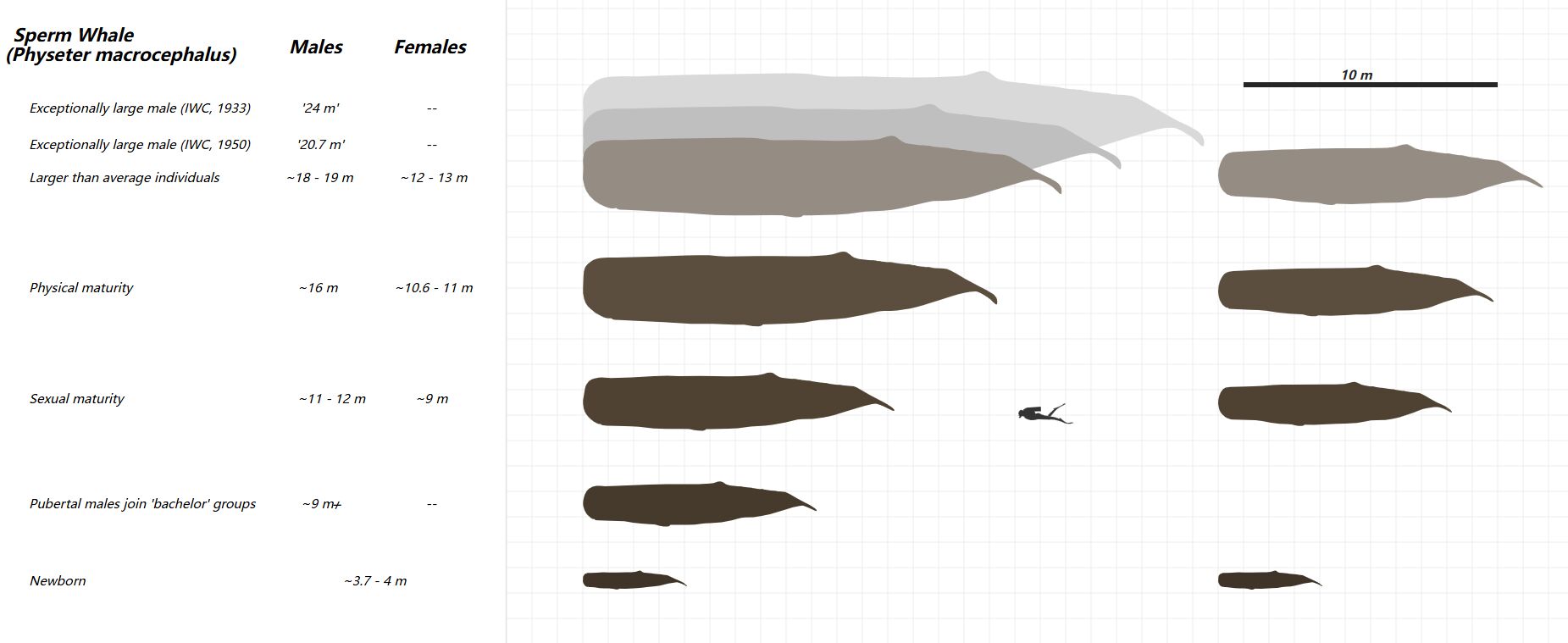Explore the remarkable growth and developmental milestones of the sperm whale (Physeter macrocephalus), the largest toothed predator on Earth. This article delves into the distinct size differences between males and females across various life stages, from newborn to exceptionally large adults. Understand the incredible anatomical and physiological journey of these deep-diving cetaceans.

Sperm Whale (Physeter macrocephalus): This is the scientific and common name for the species, identifying it as the largest extant toothed whale. The Physeter macrocephalus is renowned for its massive head, which can comprise up to a third of its body length, and its deep-diving capabilities.
Males: This column represents the size benchmarks and developmental stages specific to male sperm whales. Male sperm whales exhibit significant sexual dimorphism, growing considerably larger than females, a common trait in polygynous species.
Females: This column outlines the size benchmarks and developmental stages specific to female sperm whales. Females are smaller than males and typically remain in stable matriarchal social units throughout their lives.
Exceptionally large male (IWC, 1933): ‘24 m’: This record highlights an extraordinary individual male sperm whale, measuring approximately 24 meters, documented by the International Whaling Commission in 1933. Such immense sizes represent the upper extreme of the species’ potential growth, likely reflecting a very old and successful individual.
Exceptionally large male (IWC, 1950): ‘20.7 m’: Another historical record from the International Whaling Commission in 1950, this male measured about 20.7 meters. These historical records provide crucial data on the maximum sizes attained by sperm whales, which are rarely observed in modern times due to past whaling pressures.
Larger than average individuals: ~18-19 m (Males), ~12-13 m (Females): These figures represent the sizes for male and female sperm whales that exceed the typical average for their sex. They showcase the considerable individual variation in growth within the species, particularly the pronounced size disparity between the sexes.
Physical maturity: ~16 m (Males), ~10.6-11 m (Females): Physical maturity indicates the point at which an individual has reached its full adult size and skeletal development is largely complete. At this stage, males are significantly larger than females, demonstrating the continued growth of males long after sexual maturity.
Sexual maturity: ~11-12 m (Males), ~9 m (Females): Sexual maturity marks the age and size at which an individual becomes capable of reproduction. While males reach this stage at a smaller size than their physically mature length, females achieve sexual maturity at a comparatively smaller overall body size.
Pubertal males join ‘bachelor’ groups: ~9 m+: This indicates a behavioral milestone for male sperm whales, where they begin to leave their natal matriarchal groups and form transient bachelor pods. This occurs as they approach sexual maturity, marking a shift in their social structure and foraging patterns.
Newborn: ~3.7-4 m: This describes the size of a sperm whale calf at birth, typically between 3.7 and 4 meters in length. Newborns are already quite large, reflecting the substantial investment in prenatal development, and are immediately capable of swimming and nursing from their mothers.
The sperm whale, Physeter macrocephalus, stands as an icon of oceanic grandeur, not only for its immense size but also for its profound adaptations to the deep-sea environment. As the largest toothed whale and the largest toothed predator on Earth, its anatomy and life history are subjects of immense scientific interest. This species exhibits striking sexual dimorphism, with males growing considerably larger than females, a characteristic that becomes increasingly apparent as they progress through different life stages. Understanding these developmental milestones provides critical insights into the species’ ecology, social structure, and overall biology.
From birth to full physical maturity, sperm whales undergo a remarkable growth trajectory, dictated by their genetics and environmental factors. Newborn calves, already substantial in size, represent a significant maternal investment, emphasizing the slow growth and extended parental care typical of large cetaceans. As they mature, males embark on a journey that sees them grow significantly larger than their female counterparts, reaching imposing dimensions that enable them to compete for mates and dominate deep-ocean foraging grounds. This divergence in growth rates and ultimate body size is a key feature in the species’ life history strategy.
The data presented underscores the progressive increase in size through various stages of life, from the relatively small newborn to the colossal dimensions of exceptionally large adult males. These benchmarks are not merely statistical points but represent significant physiological and behavioral transitions. For instance, the onset of sexual maturity marks the capability for reproduction, while physical maturity signifies the completion of skeletal growth. The social transition of pubertal males joining bachelor groups further illustrates the complex interplay between physical development and behavioral ecology in these magnificent marine mammals.
Key life stages and size benchmarks for Sperm Whales include:
- Newborn: Starting at ~3.7-4 m.
- Sexual Maturity: ~9 m for females, ~11-12 m for males.
- Physical Maturity: ~10.6-11 m for females, ~16 m for males.
- Social Groupings: Pubertal males (~9 m+) form bachelor groups.
- Maximum Recorded Sizes: Exceptionally large males reaching over 20 m.
In conclusion, the life stages of the sperm whale, Physeter macrocephalus, are characterized by a profound journey of growth and maturation, vividly demonstrating the species’ impressive scale and sexual dimorphism. From the robust newborn to the towering exceptionally large males, each phase reflects critical anatomical and physiological adaptations essential for survival in the challenging deep-ocean environment. A comprehensive understanding of these developmental benchmarks is vital for conservation efforts and for appreciating the extraordinary biological legacy of this iconic marine predator.

